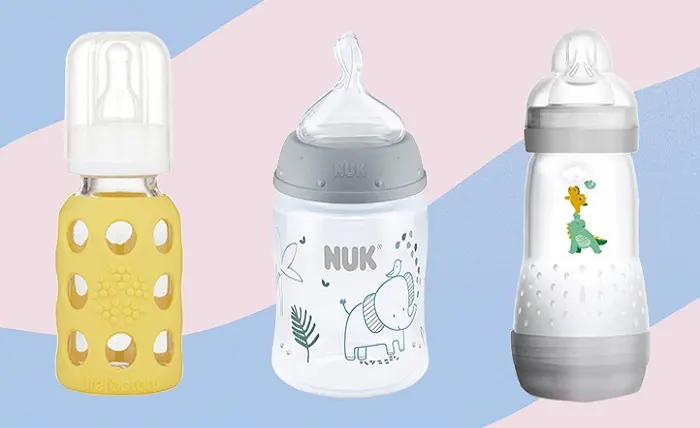Caring for a baby brings joy, challenges, and countless decisions. Among these decisions, one of the most vital for your baby’s well-being and peace of mind is choosing the right feeding Bottles. Feeding your baby can become a beautiful bonding experience when you have the perfect bottle. Yet, with the market overflowing with options, selecting the ideal one can take time and effort.
The goal is to ensure your baby gets the nourishment it needs and make this fundamental aspect of parenting a hassle-free and enjoyable experience. With considerations ranging from material and nipple types to size, shape, ease of cleaning, and innovative features, this guide will equip you with the knowledge to choose the best bottles tailored to your baby’s needs and lifestyle. This article aims to guide parents through selecting the best bottles for easy and comfortable feeding.
Consider the Material:
The first step in choosing a bottle for feeding is deciding on the material. There are primarily three options: glass, plastic, and stainless steel.
Glass Bottles: These bottles are durable and do not contain any harmful chemicals that can leach into the milk. They are easy to clean but are heavier and more prone to breaking if dropped.
Plastic Bottles: Plastic bottles are lightweight and less likely to break. However, choosing BPA-free options is essential to ensure your baby’s safety. They are also easy to clean and come in various shapes and sizes.
Stainless Steel Bottles: These bottles are highly durable and do not retain odors or stains. They are an excellent choice if you want to avoid plastic altogether. However, they can be heavier than other options.
The choice of material often depends on personal preference and lifestyle. Some parents prefer the classic feel of glass, while others opt for the convenience of plastic or stainless steel.
Nipple Types Matter:
The nipple is a critical component of the bottle, as it directly affects your baby’s comfort during feeding. When selecting a bottle, consider the following nipple types:
Standard Nipple: These are the most common type and mimic the shape of a mother’s breast. They work well for most babies, but choosing the appropriate flow rate to match your baby’s age and feeding pace is essential.
Orthodontic Nipple: Orthodontic nipples are flattened to promote proper oral development. They are an excellent choice for babies at risk for dental issues.
Anti-Colic Nipple: These nipples are designed to reduce air intake during feeding, which can help prevent colic and gas. If your baby is prone to digestive issues, consider this type of nipple.
Variable Flow Nipple: As your baby grows, their feeding needs change. Variable-flow nipples adjust to your baby’s sucking rhythm, making them suitable for older infants.
Choosing the right nipple type can significantly impact your baby’s feeding experience. It’s essential to observe your baby’s preferences and consult with your pediatrician if you’re unsure which nipple is best.
Size and Shape for Comfort:
The size and shape also play a crucial role in your baby’s comfort. Consider the following factors:
Bottle Size: Smaller bottles are suitable for newborns, while larger ones are better for older babies who consume more milk. Make sure the bottle is easy for you to hold comfortably during feeding.
Bottle Shape: Some bottles have ergonomic designs that are easy to grip, while others have unique shapes to reduce colic or make it easier for your baby to hold as they grow. Experiment with different shapes to see what works best for you and your baby.
Wide-Neck vs. Standard Bottles: Wide-neck bottles are easier to clean but may only fit in some bottle warmers or holders. Standard bottles are more versatile in this regard.
Ease of Cleaning and Assembly:
They must be thoroughly cleaned after every use to ensure your baby’s health and safety. Look for bottles that are easy to disassemble and clean. Bottles with fewer parts are generally more convenient. Dishwasher-safe bottles can also save you time and effort.
Additionally, consider the ease of assembly. Bottles with complicated mechanisms or multiple small parts may be frustrating when you’re tired during late-night feedings.
Additional Features:
Some bottles come with additional features that can enhance comfort and convenience:
Anti-Slip Base: Bottles with anti-slip bases can prevent accidental spills during feeding sessions.
Temperature Indicators: Some bottles have built-in temperature indicators that change colour when the milk is too hot, helping to prevent burns.
Travel-Friendly Designs: If you’re often on the go, look for bottles designed for travel with leak-proof caps and compact shapes.
Venting Systems: Bottles with venting systems help reduce air intake, preventing colic and gas in your baby.
Conclusion:
Choosing the best feeding Bottles for easy and comfortable feeding is a crucial decision for parents. Consider factors such as material, nipple type, size, shape, ease of cleaning, and additional features to make an informed choice. Remember that what works best for one baby may not be ideal for another, so be open to trying different options until you find the perfect bottle for your little one. Ultimately, the goal is to make feeding time a comfortable and enjoyable experience for you and your baby.

